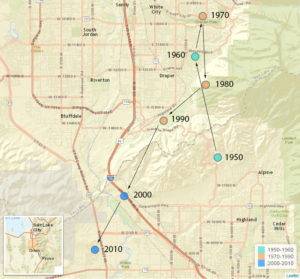Originally published in the Deseret News.
This week, the CEO of a large company headquartered in downtown Salt Lake City described the need to offer services and invest in infrastructure in Utah County. As he made his point, he looked across the table at me and asked if there was a single measure that captured the shift of Utah’s population southward.
Well, actually there is. It’s a concept known as the mean center of population. The Census Bureau defines it as the point where an imaginary, weightless, rigid and flat surface would balance if every person weighed the same. Think of it as the population center of Utah.
True to the CEO’s instincts, Utah’s population center is not only shifting south, it’s been doing so for 40 years. The mean population center or “belly button” of Utah today is in Saratoga Springs, just west of Utah Lake in Utah County.
You can track the movement of Utah’s population center in each decennial census. It tells a story of population drift in the Beehive State.
In 1950, Utah’s population center was in what is now the Draper portion of Utah County near Suncrest Drive. By 1960, largely because of Davis County’s growth as a bedroom community to Salt Lake City, Utah’s population center shifted north to Sandy, residing roughly in the current location of Hidden Valley Country Club. Ten years later, Utah’s population center shifted north again, this time landing just north of Dimple Dell Regional Park.

Then, after 1970, the relentless shift south, and eventually southwest, started to happen. This can be explained, in part, by the rapid population growth in the southwest quadrant of Salt Lake County, Utah County and further south in Washington County.
In 1980, Utah’s population center drifted to Cherry Canyon, near Draper. Ten years later, the population center jumped west, landing near the South Mountain Golf Course in Draper. In 2000, it shifted south and west again, landing north of Thanksgiving Point in Lehi. Today, Utah’s population center is in the Harvest Hills area of Saratoga Springs.
During the Manifest Destiny era, newspaper editor Horace Greeley coined the phrase, “Go west, young man, and grow up with the country.” He got it right. According to the Census Bureau, the mean center of the U.S. population moved from the state of Maryland in 1790 to Missouri today. Demographers call this movement “population drift” as the U.S. population over the last two centuries has moved westward and southwesterly.
The corollary of Greeley’s phrase applied to Utah is, “Go south, young men and women, and be part of the future of Utah.”
So, what does this southwesterly drift mean for Utah residents? I look for several things to happen.
Utah County will continue to diversify and change. It is not your grandmother’s Utah County anymore.
State and local government will pour millions of dollars into southern Salt Lake County and northern Utah County for transportation and water infrastructure. It simply has to be done.
Expect Utah’s service sector to make sizable investments in the area. New health care, accounting, architectural, engineering, education (think Utah Valley University and University of Utah), entertainment and legal services will make investments near Utah’s population center. The population will demand services; they won’t want to drive north to Salt Lake County to find them.
Finally, look for things you never thought would happen. Perhaps the Camp Williams National Guard training site will be relocated. Maybe local government will set aside a southern equivalent to Liberty Park. Perchance the Provo Municipal Airport will become a regional airport and offer more commercial flights.
I don’t know what the future holds, but one thing I do know — Utah’s population will keep growing and moving southwesterly as the buildable land supply in Salt Lake County diminishes, Utah’s Dixie continues to grow and Utah County fills with activity. The 2020 Census will reveal a new Utah population center, and I’m confident it will be in Utah County again.
